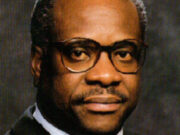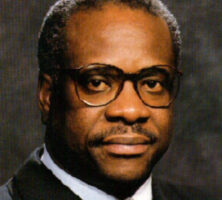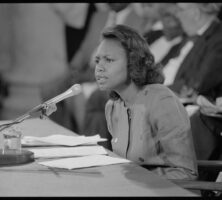Clarence Thomas was sworn in as an associate justice of the U.S. Supreme Court in 1991. At the time of his swearing in, he was the youngest member of the court and only its second African American member, after Thurgood Marshall, whose seat he filled. His televised Senate confirmation hearings in 1991 embroiled the nation in a heated debate about sexual harassment in the workplace. His Supreme Court opinions reveal an independent and staunchly conservative line of thought, which has angered civil rights supporters and won praise from judicial conservatives.
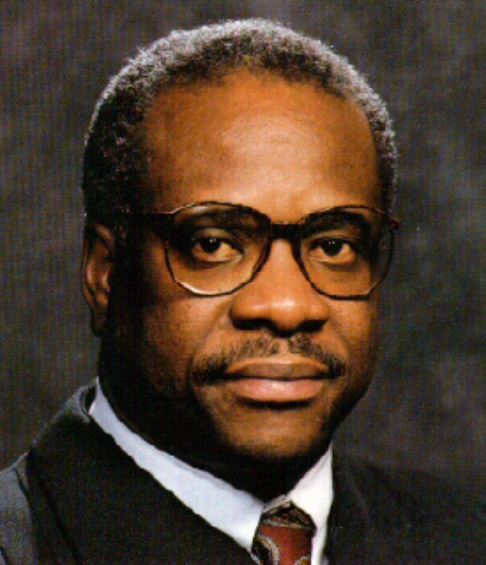
Early Life
Thomas was born on June 23, 1948, in Pin Point, a small, economically depressed community built on the grounds of a former slave plantation south of Savannah. He was abandoned by his father at the age of two. When he was six, his mother, Leola, sent him and his brother to live with their grandparents. Thomas’s grandfather, Myers Anderson, was a hard worker and made an independent living selling ice, coal, and other items from the back of his truck. A devout Catholic and a Democrat, Anderson instilled in the boys the values of strict self-discipline, financial independence, and a strong moral sense of right and wrong. Anderson was also a member of the National Association for the Advancement of Colored People (NAACP), and his friend, W. W. Law, ran the NAACP’s Savannah chapter.
Thomas’s early ambition was to join the priesthood. To that end, he attended a black parochial high school, transferring after two years to St. John Vianney Minor Seminary outside Savannah. He excelled academically though he experienced constant hazing as the only African American in his class. In 1967 he entered the Immaculate Conception Seminary in Missouri. Again he encountered racial prejudice. When he heard a fellow classmate celebrating the murder of Martin Luther King Jr., Thomas left the seminary.
In 1968 Thomas responded to a minority recruitment program sponsored by Holy Cross College in Worcester, Massachusetts, where he enrolled. There he thrived, helping to found the Black Student Union and becoming involved with various community activist organizations. He graduated near the top of his class in 1971, earning an honors degree in English.
In the fall he entered Yale Law School in New Haven, Connecticut, as part of an affirmative-action program for qualified minorities. While a student he chose business-oriented law rather than civil rights and constitutional specialties, because he wanted to avoid being labeled. “You had to prove yourself every day, because the presumption was that you were dumb and didn’t deserve to be there on merit,” he said.
Public Service
In 1974 Thomas gained his first experience in public service by joining the staff of Missouri attorney general John Danforth. Danforth was then elected to the U.S. Senate in 1977. After working briefly forthe chemical company Monsanto in St. Louis, Missouri, as an attorney, Thomas joined Danforth’s Washington staff in 1979 and specialized in environmental and energy issues. During this period Thomas’s increasingly conservative political views began to take root.
He caught the attention of U.S. president Ronald Reagan, elected in 1980, who appointed Thomas as assistant secretary of the Department of Education’s Office of Civil Rights. Showing a cautious political acumen, Thomas charted a more independent course than the administration liked. Still, within a year the Reagan administration named Thomas, at the age of thirty-three, the chairman of the Equal Employment Opportunity Commission (EEOC). Both appointments were ironic, since they involved the enforcement of a body of federal civil rights law that Thomas seemed indifferent to, at best. While at the EEOC, however, Thomas gave clear voice to the administration’s opposition to affirmative action by declining to enforce programs that set numerical goals and timetables for the hiring of minorities. Supporters of the EEOC strongly criticized this shift, contending that Thomas was undermining the agency’s purpose. They also accused Thomas of hypocrisy because he had personally benefited from such programs in the past.
In 1989 President George H.W. Bush nominated Thomas as a judge to the U.S. Court of Appeals for the District of Columbia Circuit to replace Robert Bork. (Bork resigned his seat when the Senate rejected his nomination to the U.S. Supreme Court.) The Senate promptly confirmed Thomas’s appointment.
Supreme Court Confirmation Hearings
In June 1991, at the age of eighty-two, associate justice Thurgood Marshall created a vacancy on the Supreme Court by retiring. He was the court’s first and only African American justice. President Bush saw the political necessity of replacing Marshall with another African American. On July 1, 1991, he nominated Thomas to the Supreme Court. Predictably, his choice of Thomas to replace Marshall, whose standing as a lawyer and advocate of civil rights was legendary, provoked a storm of opposition from congressional Democrats and mainstream civil rights groups. Moreover, coming close upon Bork’s rejection, Thomas’s nomination promised to open another round of acrimony about the direction of the court.
The climax of Thomas’s Senate confirmation process was the surprise appearance of a University of Oklahoma law professor named Anita Hill. Herself an African American, Hill testified that Thomas’s improper advances while she was an employee at the EEOC constituted sexual harassment. These televised allegations ignited an emotional, nationwide debate on sexual harassment and gender roles in the workplace and polarized public opinion regarding Thomas’s moral fitness for the court. Thomas denied all the charges and characterized the proceedings as “a high-tech lynching for uppity blacks.”
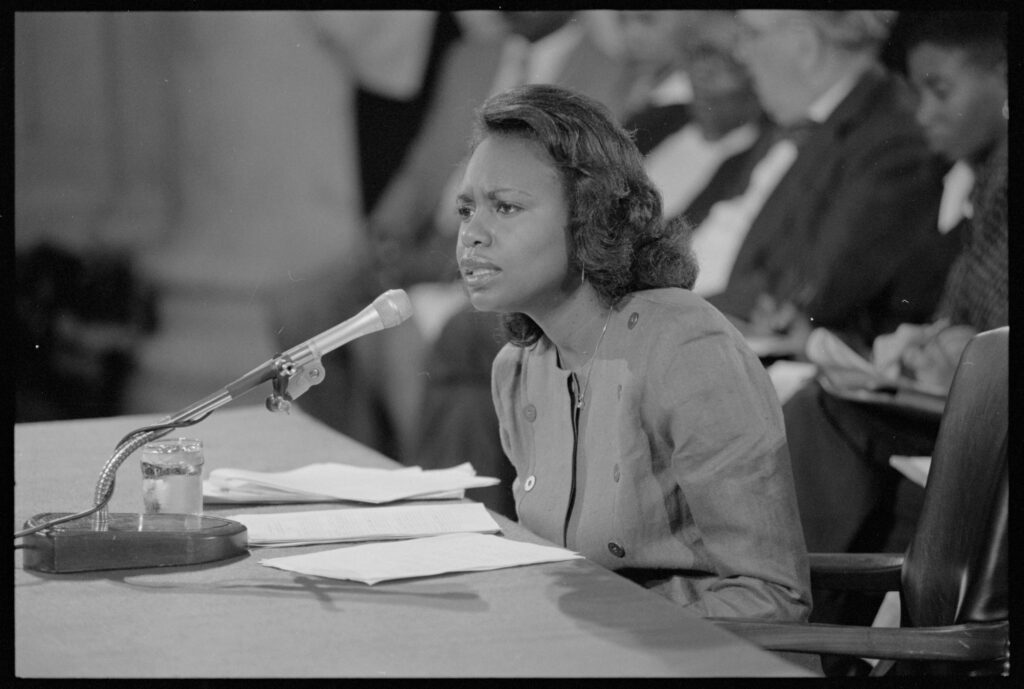
Courtesy of Library of Congress, Prints & Photographs Division
Because there was no conclusive evidence proving or disproving Hill’s testimony, the divided Senate Judiciary Committee sent the nomination to the full Senate without a recommendation. On October 15, 1991, the Senate confirmed Thomas’s nomination fifty-two to forty-eight, the narrowest Supreme Court confirmation vote of the twentieth century. On October 23 Clarence Thomas was sworn in as an associate justice of the Supreme Court.
Thomas’s Jurisprudence
After joining the court, Thomas aligned himself with its most conservative members, frequently voting with Chief Justice William Rehnquist and most often with Associate Justice Antonin Scalia. In recent years he has adopted a more assertive, conservative, and consistent approach to constitutional interpretation that sets him apart.
As a judicial conservative, Thomas generally opposes the expansion of federal guarantees under the Constitution. In Hudson v. McMillian (1992), for example, he dissented from the majority opinion that extended to prison inmates the constitution’s protection against “cruel and unusual punishment.” In a death penalty case, Thomas, in a separate concurring opinion, stated that a defendant’s poverty or misfortunes as a child were not relevant considerations.
Thomas remains opposed to racial preference programs. In his concurring opinion in Adarand Constructors, Inc. v. Peña (1995), he offered this insight into his thinking: “So-called 'benign’ discrimination teaches many that because of chronic and apparently immutable handicaps, minorities cannot compete with them without their patronizing indulgence. Inevitably, such programs engender attitudes of superiority or, alternatively, provoke resentment among those who believe that they have been wronged by the government’s use of race.”
Time has failed to mellow the opposition to Thomas, and his rare public-speaking appearances are often met with vociferous protests by minority and women’s rights groups. Conservatives, on the other hand, applaud his belief that constitutional interpretation should follow the framers’ “original intent” as well as his opposition to judicial activism.
Thomas is married to Virginia Lamp and is the father of a son, Jamal, by his first wife, Kathy Ambush. Although brought up a Catholic, he now attends an Episcopal church.
In 2007 he published a memoir, My Grandfather’s Son.


